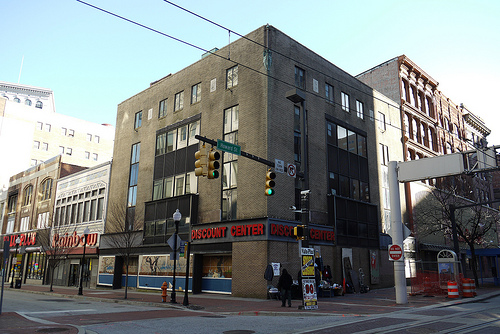Historic Baltimore Drugstore Threatened: The site of a 1955 lunch counter sit-in faces demolition in Baltimore, Preservation Magazine, February 4, 2011
Tag: Read’s Drug Store
News: Read’s drugstore flap brings Baltimore civil rights history to life
Read’s drugstore flap brings Baltimore civil rights history to life, The Baltimore Sun, February 8, 2011
Preserving Baltimore’s Civil Rights Heritage at the Reginald F. Lewis Museum
Join Baltimore Heritage & the Reginald F. Lewis Museum of Maryland African American History & Culture on the evening of February 9 for “Preserving Baltimore’s Civil Rights Heritage,” a panel discussion and public forum from 7:00 to 8:30 PM moderated & hosted by Dr. David Terry, executive director of the Reginald F. Lewis Museum. Our panelists include Dr. Gabriel Tenabe (Morgan State University) on restoring the home of long-time Baltimore NAACP President Lillie Mae Carroll Jackson, Ms. Tanya Bowers (National Trust for Historic Preservation) on the proposed National Civil Rights Heritage Trail, and Mr. Bill Pencek on the adaptive reuse of PS 103. Finally, we’ll hear the story of the Read’s Drug Store sit-in from Dr. Helena Hicks who, as a freshman at Morgan State in 1955, participated in Baltimore’s first successful sit-in protest at Read’s— a building that is currently threatened with demolition by the development of the “Superblock.”
Preserving Baltimore’s Civil Rights Heritage
The Reginald F. Lewis Museum, 830 E. Pratt Street, Baltimore, MD 21202
Wednesday, February 9, 7:00 PM to 8:30 PM
Free, RSVP today!
Parking for museum visitors is located across the street at the Dodge PMI Garage at 815 E. Pratt St. $6 validated parking is available. Transit options include MTA Bus 10 via President Street, Charm City Circulator Orange Route Stop 201, & the Shot Tower/Market Place Subway Station.
News: Read’s Drug Store on Marc Steiner Show
Read’s Drug Store, Marc Steiner Show, January 20, 2011
Why the West Side Matters: Read’s Drug Store and Baltimore’s Civil Rights Heritage

One of the West Side’s least well known but most important stories is the history of the former Read’s Drug Store at Howard and Lexington Streets and its landmark role in Baltimore’s civil rights movement. Built in 1934 by Baltimore architects Smith & May, the press heralded this Art Deco structure as a local landmark from its beginning– a modern flagship store for the Read’s chain, continuing their 50-year presence at the bustling heart of the downtown retail district.
Like many downtown commercial establishments in the early 1950s, the Read’s chain maintained a strict policy of racial segregation at their lunch counters. In 1955, a group of Morgan State students came together with the leadership of the recently organized Baltimore Committee on Racial Equality to organize a sit-in protest at the lunch counter of the Read’s Drug Store at Howard and Lexington Streets. They succeeded in this effort, marking this building as a witness to the first successful student-led sit-in protest in Baltimore and defining a powerful model for the more famous lunch-counter sit-in of Greensboro, North Carolina in 1960. This building is currently threatened with total demolition by the proposed development of the Superblock by the Baltimore Development Corporation and Lexington Square Partners. Baltimore Heritage, together with partners and supporters from across the city, is advocating for the city to reconsider this proposal and encourage the preservation and re-use of this essential landmark in Baltimore’s civil rights history.


